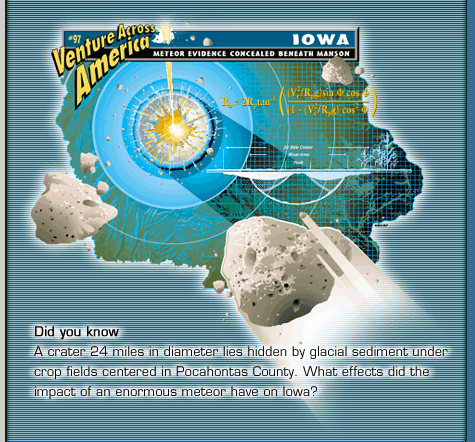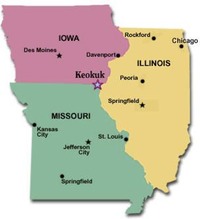
Rockhounding Iowa
Iowa is a good state for rockhounding. The state primarily is known for its ‘Keokuk geodes.’ Iowa, of course, was under a Cretaceous shallow sea and, as a result, has sedimentary deposits. Accordingly, Iowa also has fossils as well as several caves. In addition, numerous meteorites have been recovered in Iowa (for meteorite hunters, a meteorite fall on the Iowa terrain is much, much more desirable than trying to find meteorites in the Rocky Mountains or heavily forested areas).
State Rocks, Gemstones, Minerals, Fossils, & Dinosaurs
Rockhounding Tip: Knowing state rocks, gemstones, minerals, fossils, and dinosaurs often can be very useful information for rockhounders. Ordinarily, states with significant mineral deposits, valuable gemstones, fossils, or unusual or significant rock occurrences will designate an official state mineral, rock/stone, gemstone, fossil, or dinosaur to promote interest in the state’s natural resources, history, tourism, etc. Accordingly, such state symbols often are a valuable clue as to potential worthwhile rockhounding opportunities.

Keokuk Geode with Calcite
State Rock: Iowa
Geode (1967)
Iowa designated the Iowa geode as its
official state rock in 1967. The state
is well known for its geodes. The word
"geode" is derived from Latin and means "earthlike," a
reference to their rounded shape. Most
Iowa geodes are roughly spherical, often lumpy or cauliflower-like in external
form, with diameters typically ranging between about two and six inches (specimens
up to thirty inches are known). Geodes are found in limestone formations and have a
hard outer shell. The most prized
geodes have hollow interiors, although many geodes are solid objects in which
crystal growth has filled most or all of the interior volume. Geodes from the Keokuk area contain a variety
of minerals, but quartz and calcite are dominant in most. Southeastern Iowa is one of the state's best geode collecting areas.
Rockhounding Resources

State-specific rockhounding books (including the books listed here as well as other books), regional rockhounding site guides, and other helpful rockhounding resources are identified - by category - in the Books & Gear section of Gator Girl Rocks with a link to the Gator Girl Rocks Amazon Store where you may easily browse selected resources and securely place an order. Your order will benefit Charity Rocks!

Iowa Geological & Water Survey

Mid-America Paleontology Society
- Robert Wolf, Fossils of Iowa: Field Guide to Paleozoic Deposits (2006).
- Wayne I. Anderson, Iowa’s Geological Past: Three Billion Years of Change (1998).
- Stephen Sinotte, The Fabulous Keokuk Geodes – Volume I – Origin, Formation, & Development in the Mississippian Lower Warsaw Beds of Southeast Iowa and Adjacent States (1969).
- June Culp Zeitner, Midwest Gem, Fossil, & Mineral Trails: Prairie States (Rev. ed., May 1998 – first published in 1955).
- June Culp Zeitner, Midwest Gem Trails: Field Guide for the Gem Hunter, the Mineral Collector, and the Tourist (3d. Rev. ed., 1964 – originally published in 1956).
- Allan W. Eckert, Earth Treasures Vol. 3 - Northwestern Quadrant (1986; reprint in 2000).
- James Martin Monaco & Jeannette Hathway Monaco, Fee Mining & Mineral Adventures in the Eastern U.S. (2d ed. 2010).
- Kathy J. Rygle & Stephen F. Pedersen, Northwest Treasure Hunter's Gem & Mineral Guide (4th ed. 2008).
Museums of Interest to Rockhounders

University of Iowa Museum of Natural History
University of Iowa – Iowa City, Iowa
The museum’s ‘Iowa Hall’ features a ‘Geology of
Iowa’ exhibit that covers five hundred million years of geologic history. The University of Iowa also has an extensive
paleontological collection.

University of
Northern Iowa Museum
Cedar Falls, Iowa
The museum includes a permanent exhibit
pertaining to rocks, minerals, & fossils.
Madison County Historical Society
Winterset, Iowa
The museum includes exhibits on minerals and
rocks.

Sanford Museum & Planetarium
Cherokee, Iowa
The museum exhibits local rocks and fossils.
Places to Visit - Interesting Sites To See
Old Capitol Building
Iowa City, Iowa
The largest fragment of the Marion Meteorite
is on display in the Old Capitol Building.
The Marion Meteorite fell south of Marion in Linn County just before
3:00 p.m. on February 25, 1847, the day that legislation establishing the
University of Iowa was signed into law in Iowa City, which was then the State
Capitol. Residents of Iowa City were
alarmed by the series of loud explosions to the north.

Geode State Park
Henry, Iowa
Geode State Park, in southeastern Iowa,
is named for the occurrence of geodes. The park office has a display of geodes.
Note: In Iowa, it is illegal to
remove geodes from state parks.

Manson Crater – aka the Manson Impact Structure
North central Iowa near Manson, Iowa
The Manson Crater is the location where a
mountain-sized meteorite hit the planet – at 45,000 miles per hour – about 74
million years ago. The crater is not
visible from the surface. Rather, it is
deep underground buried by glacial till from the glaciers of the last ice age.

Devonian Fossil Gorge
Coralville, Iowa
Following a flood in 1993 (and again in 2008)
that caused Coralville Lake to overflow, a 375 million year old limestone seabed
was revealed. The Devonian Fossil Gorge
is located along the Iowa River.
Visitors can see various marine fossils including brachiopods, corals,
trilobites, and crinoids. The U.S. Army
Corps of Engineers has a Visitors’ Center at the Dam that has geologic
information and fossil displays.

Grotto of the Redemption
West Bend, Iowa
Located in north central Iowa, the Grotto of
the Redemption is a religious monument.
The structure consists of nine grottos depicting scenes in the life of
Jesus. The structures contain a very
large collection of rocks, minerals, gemstones, and fossils from around the
world.
Rockhounding Sites for Children & Families

Geodes
Keokuk, Iowa
Although geodes
are known from many localities around the world, one of the most productive and
famous collecting regions is encompassed within a 50-mile radius of Keokuk,
Iowa. Iowa's renowned ‘Keokuk geodes’
can be found in specific stream drainages and excavations in parts of
southeastern Iowa (especially in Lee, Henry, and Van Buren Counties), including
the area near Geode State Park. Most
geodes are derived from strata of the lower Warsaw Formation, a widespread rock
unit of Mississippian age. Muds
deposited in a shallow sea about 340 million years ago were primarily calcium
carbonate and clay, and were subsequently lithified to form the shales, shaley
dolomites, and limestones that we see today. Fresh geodes can be dug out of exposures of
the lower Warsaw Formation, where they are concentrated in certain layers. Where water and streamflow have eroded these
strata, concentrations of geodes may accumulate in stream channels. Although the bulk of Iowa's geodes are derived
from the Warsaw Formation, geodes also are known from other formations of
Devonian and Mississippian age at scattered localities in eastern and central
Iowa.

Devonian Marine Fossils
Floyd County Fossil & Prairie
Park Center – Rockford, Iowa
This public
park, located west of Rockford, is one of the few geological preserves that
allows specimen collecting for private use.
The site, which was a former clay pit for a brick and tile company, is a
Devonian strata with abundant marine fossils, including brachiopods. The soft sediment allows fossils to weather
out.
